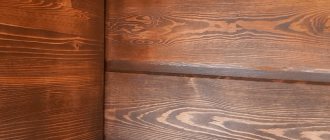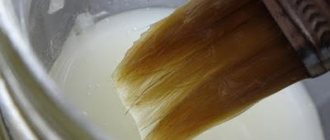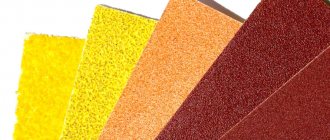Wood is considered a popular material in construction. Its versatility, general availability, and optimal price allow it to be used for any production needs. This raw material is used to create walls, strengthen the roof, and cover the floor. A significant disadvantage that is characteristic of wood is that it is not able to withstand the influences of the external environment.
Bitumen mastic protects wood from moisture and gives it antiseptic properties.
To increase service life and protect raw materials, the material should be systematically treated with special means. With their help, you can protect the coating from the harmful effects of water, dust, dirt, improve its appearance, and prevent the occurrence of scuffs. One such substance that maintains the high quality of a wooden floor is bitumen or wax wood mastic.
Why do you need mastic?
When used correctly, these compounds help protect wood from swelling and deformation and create a reliable protective layer that:
- preserves natural color and makes it brighter;
- emphasizes the natural pattern of the fibers;
- reliably protects the wooden surface from dust and moisture.
Mastic saturates the wood with protective substances, making it resistant to moisture and giving it antiseptic properties. Wooden log houses treated with a special mastic can withstand wintering well, without fear of frost or snowfall. These compounds protect fibers, and regular treatment helps increase the service life of buildings for many years.
Reasons to treat wood with mastic
Wood is a “capricious” material with a low degree of natural protection from an aggressive environment. It is prone to rot and mold. And therefore, to the question, is it possible to treat wood with bitumen mastic? - the answer is obvious. It's simply necessary.
In addition to protection from moisture, mastic will provide the following:
- possibility of leveling the floor surface;
- improvement of appearance;
- protection against abrasions;
- counteraction to pollution, mold and fungal development;
- increase in service life;
- emphasizing the natural pattern of the fibers;
- imparting antiseptic properties to wood;
- resistance to ultraviolet radiation.
Composition and main characteristics
Wood mastic is prepared from a variety of components and comes in different varieties. But in general, mastics have one common property: excellent waterproofing. If they contain natural components, then the protective layer can stretch, exceeding the original area by more than 20 times, but without spreading or deforming.
Some compounds do not harden completely even many months after application. They have excellent adhesion: they fit well on a wooden surface and do not come off for a long time.
Mastic allows you to create a water-repellent layer, provides resistance to dust, ultraviolet radiation and various contaminants. The main advantage over conventional varnish is that it penetrates deep into the fibers and extends their service life, rather than remaining on the surface, like conventional compounds.
Treatment with mastic protects the log house from moisture, rotting and ultraviolet exposure
One-component and two-component mastic
One-component . Ready-to-use solution, without the need for dilution or other manipulations. This shows the simplicity of the work, since you don’t have to spend time on preparation. The disadvantage is that after opening the container, the coating begins to harden, and the mastic that we did not use will become useless in the future.
Two-component. As the name implies, this type of mastic consists of two components that are mixed in the required proportions, thus turning into a mixture ready for use. Separately, the components can be stored for a very long time, so this type of mastic is much more economical.
Advantages and disadvantages
If you want to combine all the advantages of wood mastic and display them in a general list, it will look like this:
- Environmentally friendly. Here you need to take into account the composition of the substance.
- Durability. With regular care, wooden products can last for tens or even hundreds of years.
- Elasticity. It stretches well.
- Easy to apply. Mastic can be used by a person who does not have much experience in repair or construction.
- Protection against heavy loads. Wooden floors crack less and retain their structure.
- Improved aesthetics. Mastic gives the wood a pleasant shine, makes its color more rich and noble.
The disadvantage is that it is necessary to renew the coating 1-2 times a year. In addition, some formulations contain caustic chemicals, including gasoline and solvents, which evaporate and rise into the air when dry. This directly applies to cold-curing mastic. If you use one of these, you need to wear a protective mask, wait a few days and ventilate the room well before moving in.
The benefits of using mastic
Waterproofing is the main advantage of using mastic and its main purpose. The use of this processing material increases the wood's resistance to wear, improves its aesthetic characteristics, simplifies further cleaning, and much more. Floors protected with this composition receive protection from pests. For the same purpose, other wooden surfaces are treated with mastic.
Classification of mastic
It is worth taking a closer look at what kind of mastic can be found on sale and for what purposes it is intended. This useful information will help you make your choice.
Separation by technological features
Based on this factor, wood mastic is divided into 2 types:
- cold;
- hot.
The first contains gasoline, solvents and white spirit. If these fumes dry out, they can be harmful to health. The second is made from bitumen and rubber, and therefore is considered more environmentally friendly. It dries much faster.
Separation by composition
The product can be made not only from those components that were given above. For example, hard mastic for rubbing floors is made from beeswax, and it is effective and durable.
If you are treating floors that were previously laid with bitumen mastic (for waterproofing), then you cannot use products that contain turpentine. In such a case, it is better to consult a specialist.
There are also mastics:
- one-component - intended for one-time use, as they harden quickly;
- two-component - more suitable for reusable use, but first they must be mixed with a special thickener.
Application methods
Wood is protected with bitumen mastic using the painting method. That is, it is applied like regular paint using a brush or roller. It’s true that it will be difficult to wash the tools after work. This method is also suitable for small spaces. Bitumen mastic is viscous and quite difficult to work with. If you plan to waterproof a large area, it is worth considering a simpler and more economical method - spraying. Only it requires special equipment and skills to work with it. Such processing should be entrusted to professionals.
Features of hot solutions
They have deep penetrating ability and durability. This mastic can protect wood even from damp soil and constant humidity, and therefore is used for treating basement floors, pillars and floor joists.
To apply such a mastic, it is necessary to heat it to a temperature of about 180 degrees Celsius. The process of using hot compounds is associated with health risks, since severe burns can occur.
Using a gas burner to impregnate wood with mastic
Cold and hot mastic
Cold. The mixture is based on various chemical solvents, such as white spirit. It usually takes several days for a floor covered with such mastic to dry completely. Moreover, all this time there will be a strong chemical smell in the room, which is not only unpleasant, but also dangerous to health. So it is still advisable not to occupy the premises for several days.
Hot. Mastic created on the basis of bitumen or rubber. Before use, it must be heated to the desired temperature and consistency. This temperature, by the way, reaches 180 degrees Celsius. So you need to work with such a composition as carefully as possible so as not to get burns. You also need to be careful because the composition is fire hazardous. The advantage of this composition is that it hardens very quickly - up to several minutes.
How to apply this material to the surface of wood
To apply mastic you can use:
- a brush with coarse bristles;
- an ordinary paint roller;
- spray gun.
Due to cost-effectiveness and availability, it is recommended to use a roller and brushes. They don't require much practice and are cheap, so you can always buy new tools at any hardware or hardware store.
Bitumen mastic – other applications
Having serious waterproofing properties, bitumen mastic is used not only for wood. For example, bitumen mastic is actively applied to concrete structures. The operating rules in this case are as follows:
As soon as the concrete hardens, it is cleaned of sand and dust. After this, in order to ensure better adhesion, the concrete must be treated with a bitumen primer. If this primer is well absorbed into the concrete, then it is best to reapply the layer. After this, you can proceed directly to applying mastic, choosing a bitumen or bitumen-polymer variation. In case of excessive thickness, the composition can be diluted with turpentine.
Making your own mastic
If you don’t want to use ready-made mastic for one reason or another, you can make it yourself. To do this you will need the following components:
- wax (carnauba or beeswax) - 4 parts by mass;
- rosin (pine or gum) - 1 wt. share;
- turpentine (gum) - 2 wt. shares.
Strictly follow the indicated proportions. First you need to grate the wax and mix it with crushed rosin. Then this mixture is melted in a water bath (you need to stir it systematically).
Next comes the most dangerous part. Turpentine is very flammable. It must be heated in a container with hot water and avoid exposure to open flames. Heated turpentine is added to the prepared mixture of wax and rosin and mixed thoroughly.
At the last stage, the resulting mass is poured into a container. It cools and thickens, after which it can be used for application to wooden surfaces. Using mastic, you don’t have to worry about the condition of the wood: the coatings will be protected from abrasions, dirt and the appearance of unwanted microorganisms.
What is it used for?
Such mixtures, when used correctly, perfectly protect the tree from swelling and changing shape, they provide a good layer of protection, it:
- Makes the natural tone of wood more saturated.
- Highlights surface structure.
- Perfectly protects the surface from dirt and water.
The mixture impregnates the wood and gives it protection, so the surface becomes more resistant to moisture, while the material also acts as an antiseptic.
Log houses made of wood, which are coated with a special composition, withstand the winter period well and do not react to sub-zero temperatures and snowstorms.
Such materials preserve fibers; periodic overlapping of wood increases the service life of buildings.
Rules for working with substances on wood
Work must be carried out with protected hands and gloves.
The composition has a high viscosity, so even when hot it does not blur, but during the application procedure you must definitely use protective equipment for the face and eyes.
The wooden base is cleaned of various contaminants and allowed to dry. If there is an old coating, it is completely removed, since the new coating may not saturate the material.
How to make mastic from wax?
Here is another recipe for how to prepare wax mastic: Take 100g of wax, 25g of crushed rosin and 50g of purified turpentine. The product is rubbed with it and rubbed in with a piece of cloth or wool until the fabric stops sticking and a shine appears. Sometimes resin or cherry gum is added to the mastic.
Interesting materials:
How to disable remote access to a Windows 10 computer? How to disable remote access on Windows 10? How to disable USB ports in Windows 7? How to disable Windows 7 low memory notification? How to turn off Chrome notifications on Windows 10? How to disable Windows 10 keyboard from turning on your computer? How to disable Windows 10 keyboard from turning on PC? How to disable Voice Assistant Windows 10? How to disable all antiviruses on Windows 10? How to turn off all background programs in Windows 10?
Nuances of hot compounds
Such mixtures have good permeability into the material and a long service life.
This product perfectly protects wood from dampness and moisture, so it is great for finishing bases, pillars, and so on.
To work with such mastic, the composition is heated to +180°. The use of hot substances is dangerous to human health, as there is a risk of getting burned.











